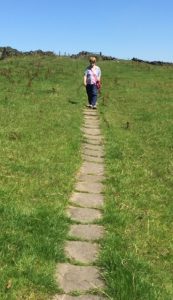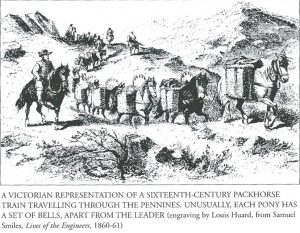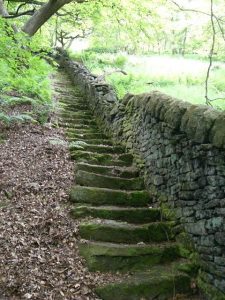
To understand our network of paths you have to forget about modern forms of transport. In the 17th century the current valley bottom route of the railways, canals and roads were marshes and most rivers could only be crossed in the summer. The only through roads were the so-called Kings Highways, but these were in such a primitive state that many of them could also only be used in the Summer!
However, there was a network of well-defined routes used for Packhorse trains. These were used to transport wool and cloth from the upland farms that produced the wool and wove the finished cloth. If you see a causey stone path running over the tops or between farms the route was likely used for this purpose.

Packhorse trains could travel 30 miles in a day, they carried over 100 kg (16 stone) and they could be 30-40 horses in a train. If you heard their bells, you would be wise to get out of the way!
To explore these routes, there is a great e-Trail Packhorse paths in Blackshawhead. If you want more detail on the history of packhorse paths you can purchase a copy of the book ‘As Seen on Packhorse Tracks’ by Titus Thornber, it costs £15 but full of fascinating information and wonderful photographs.

Around the 1850s weaving and spinning moved into mills first powered by water and then by steam. The mill owners had to provide a route for the weavers to come down from the upland farms to the mills in the valleys. To do this, they created a new set of paths often with wonderful flights of stone steps – they are a such a surprise when you come across them. Hebden Bridge Walkers Action collected over 800 photos of stone steps in the area as part of its Stepping Out project.
There are other paths and tracks with a specific use such as extracting timber, transporting stone from quarries, constructing reservoirs and providing access to hunting areas.
So you are spoiled for choice, but wherever you walk, you will be walking through history!
